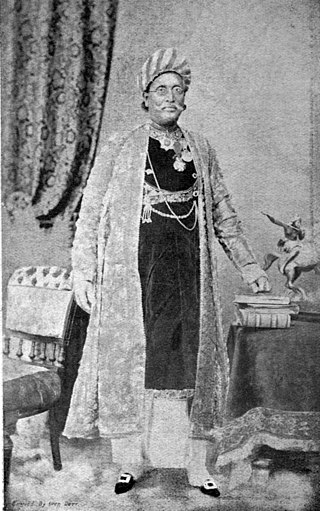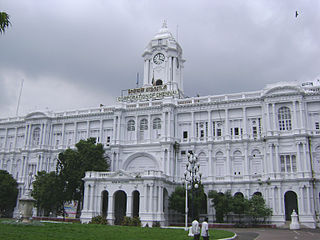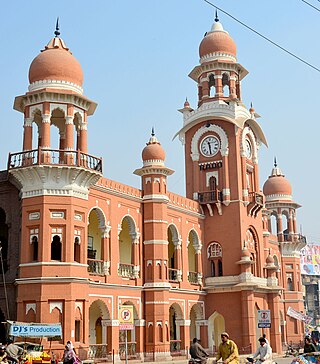This article needs additional citations for verification .(June 2015) |
| |||||
| Centuries: | |||||
|---|---|---|---|---|---|
| Decades: | |||||
| See also: | List of years in India Timeline of Indian history | ||||
Events in the year 1883 in India.
This article needs additional citations for verification .(June 2015) |
| |||||
| Centuries: | |||||
|---|---|---|---|---|---|
| Decades: | |||||
| See also: | List of years in India Timeline of Indian history | ||||
Events in the year 1883 in India.

New Delhi, is the capital of India and a part of the National Capital Territory of Delhi (NCT). New Delhi is the seat of all three branches of the Government of India, hosting the Rashtrapati Bhavan, Sansad Bhavan, and the Supreme Court. New Delhi is a municipality within the NCT, administered by the NDMC, which covers mostly Lutyens' Delhi and a few adjacent areas. The municipal area is part of a larger administrative district, the New Delhi district.

George Frederick Samuel Robinson, 1st Marquess of Ripon,, styled Viscount Goderich from 1833 to 1859 and known as the Earl of Ripon in 1859 and as the Earl de Grey and Ripon from 1859 to 1871, was a British politician and Viceroy and Governor General of India who served in every Liberal cabinet between 1861 and 1908.

The Imperial Order of the Crown of India is an order in the British honours system. The Order was established by Queen Victoria when she became Empress of India in 1878. The Order was open only to women, and no appointments have been made since the Partition of India in 1947. The Order was limited to British princesses, wives or female relatives of Indian princes and the wife or female relatives of any person who held the office of:

The Delhi Durbar was an Indian imperial-style mass assembly organized by the British at Coronation Park, Delhi, India, to mark the succession of an Emperor or Empress of India. Also known as the Imperial Durbar, it was held three times, in 1877, 1903, and 1911, at the height of the British Empire. The 1911 Durbar was the only one that a sovereign, George V, attended. The term was derived from the common Persian term durbar.

Nawab Bahadur QaziAbdul Latif was a Bengali Muslim aristocrat, educator and social worker. His title, Nawab was awarded by the British in 1880. He was one of the first Muslims in 19th-century India to embrace the idea of modernisation.

Sir Courtenay Peregrine Ilbert, was a distinguished British lawyer and civil servant who served as legal adviser to the Viceroy of India's Council for many years until his eventual return from India to England. His later career included appointments as the First Parliamentary Counsel (1899–1902) and as Clerk of the House of Commons from 1902 to 1921.

The British Raj was the rule of the British Crown on the Indian subcontinent, lasting from 1858 to 1947. It is also called Crown rule in India, or Direct rule in India. The region under British control was commonly called India in contemporaneous usage and included areas directly administered by the United Kingdom, which were collectively called British India, and areas ruled by indigenous rulers, but under British paramountcy, called the princely states. The region was sometimes called the Indian Empire, though not officially.

The Colonial and Indian Exhibition of 1886 was held in South Kensington in London with the objective to "stimulate commerce and strengthen the bonds of union now existing in every portion of her Majesty's Empire". The exhibition was opened by Queen Victoria, and when it closed had received 5.5 million visitors.

The Ilbert Bill was a bill introduced to the Imperial Legislative Council (ILC) of British India on 9 February 1883 which stipulated that non-white judges could oversee cases that had white plaintiffs or defendants. It was drafted by and named after British civil servant Sir Courtenay Ilbert, then serving as the legal advisor to Council of India, which was head by Governor-General of India Lord Ripon.

Surendranath College is an undergraduate college affiliated to the University of Calcutta, in Kolkata, India. It was founded in 1884 by the nationalist leader and scholar Surendranath Banerjee. It offers undergraduate and postgraduate level courses in various arts, commerce and science subjects.

The Ripon Building is the seat and headquarters of the Greater Chennai Corporation in Chennai, Tamil Nadu. It is an example of neoclassical architecture, a combination of Ionic and Corinthian styles. The Ripon Building is an all-white structure and is located near the Chennai Central railway station.

Clock Tower, formerly known as Northbrook Tower, is a clock tower and city government headquarters of Multan in the Punjab province of Pakistan.
Events in the year 1884 in India.
Events in the year 1882 in India.
Events in the year 1881 in India.
Events in the year 1880 in India.
The Calcutta International Exhibition world's fair was held in Calcutta from the end of 1883 to March 1884.
The European and Anglo-Indian Defence Association was a pressure group formed in British India. The group's founder and president was the industrialist John Johnstone Jardine Keswick. The Association has been described as "primarily, the political party of India’s non-official British". The Association was particularly well-known for opposing the Ilbert Bill, and was criticised as a "Defiance" Association. Several tea and Indigo planters were members of the Association.